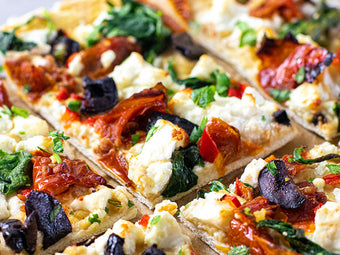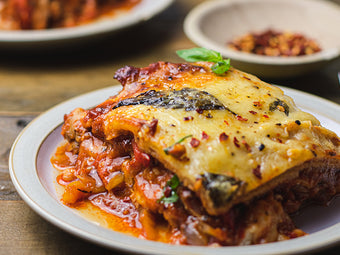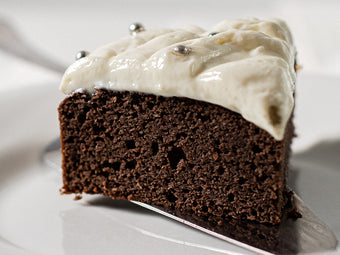10 healthy food swaps a nutritionist would make
10 healthy food swaps a nutritionist would make
Introducing food swaps into your diet is one of the easiest ways to eat healthier. Gradually making small changes is likely to make the biggest difference to your diet in the long term. We asked one of our nutritionists, Gemma, to recommend her top 10 healthy food swaps.
Do you find walking down the cereal isle of the supermarket daunting? Hundreds of brightly coloured boxes calling out at you and claiming to be ‘high in fibre’ and ‘contain added vitamins and minerals’. Well you’re not the only one.
Having a nutritious breakfast is crucial, especially for young children, to help set you up for the day ahead. If chosen correctly, cereal can be part of a healthy, balanced diet. However, most of the cereals that sit on the shelves, are highly processed and contains lots of refined sugar.
Familiarising yourself with food labels, by reading the front and back of pack nutrition label and the ingredients list, will make it easier for you to compare products. Look for cereals that contain wholegrains and are higher in fibre and lower in sugar. Examples include porridge oats, wholewheat cereal biscuits, shredded wholegrain pillows, bran flakes and some mueslis. Add fresh fruit like banana and blueberries, dried fruit like raisins, or different nuts and seeds to your cereal.

Juices and smoothies both contain vitamins and minerals however to make a juice you have to extract the pulp, which leaves most of the fibre behind. Smoothies include every part of the fruit and vegetables and are therefore much higher in fibre. In the UK, we currently do not eat enough fibre, at around only 18g a day compared to the recommended 30g.
Juices are also likely to contain more sugar than smoothies, and because of the lack of fibre, the sugars become much more easily absorbed by the body and therefore raise blood glucose levels quicker. It’s important to remember that the recommended portion size of a juice is only 150ml.
When making a smoothie, try to include a good mix of fruits and vegetables. Then once your taste buds begin to adjust, you can reduce the fruit and increase the vegetable content, which will be lower in sugar. You could also add a source of protein such as nuts, nut butters and seeds to your smoothie.

Yogurt contains beneficial bacteria which support gut health and is a good source of both protein and calcium. Many of us eat it regularly for breakfast, as a snack or as a dessert. However, many people are surprised to learn how much sugar is hidden inside yogurt, with some 125ml pots containing around 15-20g of sugar. Be cautious when reaching for the low-fat option, as often these yogurts have extra sugar added to them to compensate for removing the fat.
The healthiest choice would be to go for natural or Greek yogurt and add your own toppings such as fresh fruit, nuts, seeds and honey. Greek yogurt has been strained so contains more protein than regular yogurt. Yogurt will naturally contain around 5g of sugar per 100g, so any sugar over this amount will likely come from added sugar.
When it comes to white potato, most people associate them with unhealthy options like chips, which are deep fried in oil and are high in salt. However, both white and sweet potatoes contain a good amount of fibre and a variety of vitamins and minerals, such as potassium, magnesium and vitamin C. Whilst white potatoes contain more protein, sweet potatoes are richer in vitamin A and have a lower glycaemic index. This means they take longer to digest and have less of an impact on blood sugar levels. Sweet potatoes also count towards one of your five a day, whereas white potatoes do not.
Both types of spuds are a healthy choice and are great eaten as a baked potato, mash or made into chunky wedges. If you always go for white potato, mix it up and opt for a sweet potato next time.
Pastry is usually made from refined white flour, butter (or margarine/vegetable oils) and a number of preservatives. It is often high in calories and contains very low levels of vitamins and minerals. If you regularly like to enjoy pastry dishes such as pies, quiches, tarts and pastries, Lo-Dough can be a healthier choice. Compared to regular dough, Lo-Dough does not contain any refined flour and is an excellent source of fibre and protein. It also allows those on a low-carbohydrate, low-calorie diet, the chance to still enjoy pastry dishes.

Refined carbohydrates such as white bread, pasta, rice and couscous, have been processed to remove the outer germ and bran. This removes most of the foods nutritional value including the fibre, B vitamins, calcium and iron. When a food has been stripped of its fibre, it is broken down by the body much more quickly and can cause a spike in blood glucose levels.
Including plenty of wholegrains in your diet will help to support your digestive system and reduce your risk of developing heart disease. The Eatwell Guide recommends that around a third of your plate should be made up of starchy foods such as wholegrains. Choose wholegrain varieties whenever you can but remember that a healthy diet is about balance, so it’s ok to eat French bread every now and then.
Meat is an excellent source of high quality protein, iron and vitamin B12. However, it is high in saturated fat and many of us are still eating too much of it. Eating too much saturated fat can raise your cholesterol levels and increase your risk of heart disease.
Replace some of the meat in your diet, particularly processed meats like bacon, ham and some sausages and bacon, with a variety of beans and lentils. Add them into soups, stews, curries and salads. As well as being a good source of protein, beans and lentils are also rich in fibre, which helps to support digestive health. Reducing your meat intake aligns with the newly proposed Planetary Health Diet, which aims to provide nutritious food to the worlds growing population and address the present and future farming issues.
Snacking can be part of a healthy, balanced diet however many of us reach for the wrong types of snacks. Crisps are one of our most loved snacks but they often leave us wanting more. Crisps are usually deep fried in oil and very high in salt. Next time try swapping your packet of crisps for a healthier snack such as nuts, which are a good source of protein, fibre, healthy fats and vitamin E. Alternately you could opt for a healthier packet of crisps, such as a baked or popped variety, or one that is made from a grain so is higher in fibre.
In the UK we love a good chunk of cheddar cheese and although it is a good source of protein, calcium and phosphorus, it is also very high in saturated fat. Too much saturated fat in the diet can raise the levels of bad cholesterol and increase the risk of heart disease. Replace foods rich in saturated fat, with foods than contain unsaturated or what we call healthy fats. Examples include avocado, nuts, seeds and some vegetable oils. If you regularly eat cheese in your sandwich or in a salad, swap it with half an avocado.
We all love a piece of milk chocolate every once in a while, but if you like to eat chocolate regularly, opt for 70% dark chocolate. Dark chocolate contains half the amount of sugar as milk chocolate, as well as five times the fibre and higher levels of micronutrients like iron, zinc and magnesium. Dark chocolate is famously known for its high antioxidant level in the form of flavanols and polyphenols. Raw cocoa beans (or cacao beans) which are used to make chocolate contain one of the highest levels of antioxidants of any food. The higher the cocoa percentage of the chocolate, the more antioxidants it will likely contain. If the chocolate is raw it will also contain higher levels of antioxidants, as the roasting process used to make regular chocolate destroys some of these antioxidants.











